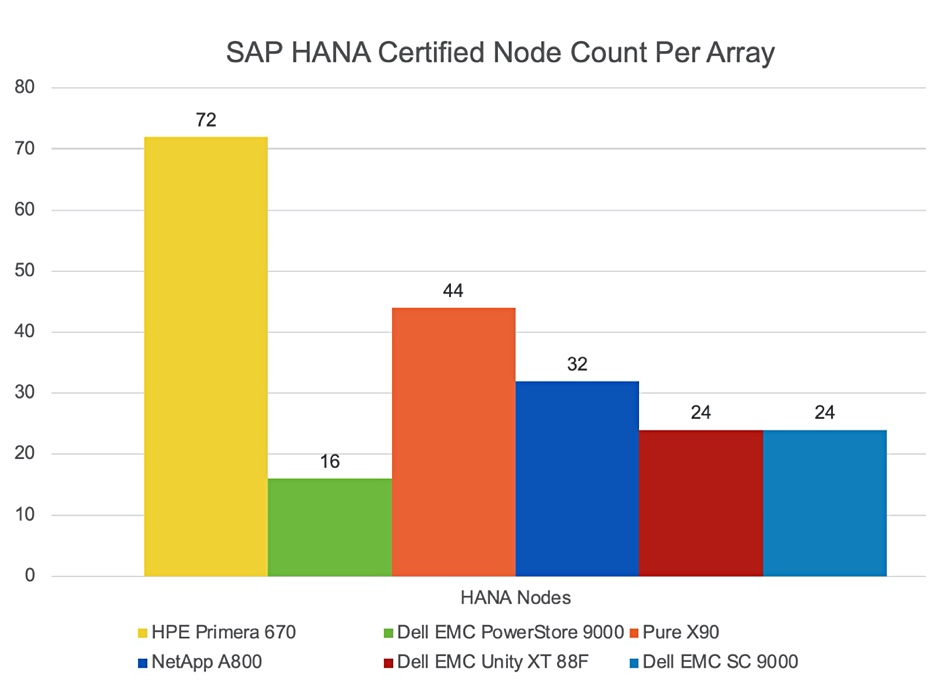Dell EMC-commissioned Principled Technology testers say PowerStore performs better than HPE’s Primera array while HPE, citing Dell EMC’s own numbers, says Primera performs much better than PowerStore.
Yes, we are also confused by this tit-for-tat exchange.

Principled Technology’s report says that, compared to the HPE Primera A670, the PowerStore 7000T has;
- Up to 3.5x better data reduction
- Up to 135 per cent more bandwidth
- Up to 209 per cent more IOPS
- Lower latency
The PowerStore 7000T is a 2-controller, all-NVMe flash drive array in a 2U chassis, offering unified file and block storage with always-on deduplication and RAID 5 data protection. The Primera A670 is a dual-controller external block storage array with a low-end 2U, 2-controller configuration. It is also all-flash, uses NVMe SSDs, and employs an ASIC for deduplication and other functions.

Principled Technologies used Vdbench to test block storage IO performance on the 7000T and the hyperconverged, VM-hosting 7000X, and the Primera A670. It tested IOPS, bandwidth and latency and you can inspect the full test details in a separate document.
We have ignored the 7000X results, as comparing a hyperconverged infrastructure appliance to an external storage array is not an “apples for apples”performance comparison.
Test results
The PowerStore 7000T “offered an overall 7.1:1 data reduction ratio compared to the 2.0:1 ratio of the HPE Primera A670.”
The PowerStore 7000T delivered 232,602 IOPS while the A670 provided 75,160 IOPS with data reduction turned on and 171,772 with data reduction turned off. The test used an 8KB random 100 per cent write workload. The PowerStore also performed better than the Primera on mixed read-write workloads.
Looking at bandwidth, the PowerStore provided 23,239 MB/sec on a random read workload compared to the Primera’s 10,763. Sequential read testing saw the Primera’s 9,877 MB/sec eclipsed by the PowerStore’s 23,238 MB/sec.
PowerStore’s latency was 0.5ms with an OLTP‐like mixed read-write workload comprised of 8KB and 128KB block sizes and a variety of read/write ratios at a fixed IOPS rate. The Primera’s latency was 2.01ms, four times longer.
Principled also looked at array snapshot restores, with a snapshot restore of 10 LUNs mounted as raw device mappings (RDM) onto a single VM. The PowerStore 7000T took a little over a minute, requiring just 16 steps. The Primera A670 array took over 20 minutes and 31 steps.;
Te testers concluded “PowerStore 7000 series arrays reduced data more efficiently and offered greater storage performance, as measured by IOPS, bandwidth, and latency” than the Primera A670; an apparently clear cut result.
Dell EMC is a SAP
HPE’s Dimitris Krekoukias, a global technologist and architect, delivered a robust response, citing Dell EMC’s own PowerStore performance numbers to show that Primera blows PowerStore away.
Krekoukias says he tried replicating the Principled Technology numbers but “I can’t come evenremotely close to replicating;any of their numbers.” Instead he looked at how many SAP HANA nodes the storage system can reliably support, using SAP’s certified system list.

A 2-controller A670 supports 36 SAP HANA nodes while a 4-controller one can run 72. The PowerStore 9000T, which has 112 controller cores compared to the 7000T’s 80, supports just 16 SAP HANA nodes. In other words the Primera A670 performs at more than two times better than the PowerStore 9000T when supporting SAP HANA nodes.
Krekoukias asks: “If the PowerStore is as fast as Dell claims in their FUD document, why isn’t it able to support many, many more SAP HANA nodes than 16?”
He points out that the Primera’s RAID 6 protection is also better than PowerStore’s RAID, and declares; “A Primera 670 is multiple times faster than a PowerStore 9000T [and 7000T], has stronger data protection, and much higher uptime.”
B&F understands that the HPE EULA (Ed User License Agreement) doesn’t prohibit anyone from publishing performance results. The Dell and VMware EULA does.
Comment
Are the Principled Technology testers’ results wrong? We don’t know. This situation is why we need independent and verifiable external benchmarks which neither vendor references in their own performance statements. Don’t they want objective performance test results?
Still, it brings a smile to our face when HPE devalues Dell EMC’s sponsored test attacking Primera by referring to Dell EMC’s own SAP HANA certification tests – which show Primera is better in real-world scenarios. Dell EMC has been hoist by its own petard.








